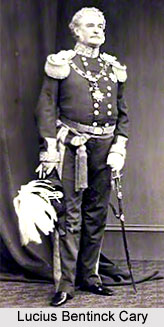 Lucius Cary, also known as Lucius Bentinck Cary, 10th Viscount Falkland GCH, PC, served as one of the Governor of Bombay Presidency from the year 1848 to 1853, in former undivided India under the rule of the British East India Company. He was also one of the renowned a colonial administrators and a Liberal politician. He was born on 5 November 1803, as son of Charles John Cary, 9th Viscount Falkland, and his wife Christiana. After the death of his father in the year 1808, he succeeded as 10th Viscount Falkland at the age of 5 years. In the year 1831, Lucius Cary was a Scottish reformer and was later elected to the House of Lords as a Scottish representative peer. He became Baron Hunsdon, of Scutterskelfe in the County of York, in the Peerage of the United Kingdom on 15 May 1832. This title gave him a seat in the House of Lords. He was also admitted to the Privy Council.
Lucius Cary, also known as Lucius Bentinck Cary, 10th Viscount Falkland GCH, PC, served as one of the Governor of Bombay Presidency from the year 1848 to 1853, in former undivided India under the rule of the British East India Company. He was also one of the renowned a colonial administrators and a Liberal politician. He was born on 5 November 1803, as son of Charles John Cary, 9th Viscount Falkland, and his wife Christiana. After the death of his father in the year 1808, he succeeded as 10th Viscount Falkland at the age of 5 years. In the year 1831, Lucius Cary was a Scottish reformer and was later elected to the House of Lords as a Scottish representative peer. He became Baron Hunsdon, of Scutterskelfe in the County of York, in the Peerage of the United Kingdom on 15 May 1832. This title gave him a seat in the House of Lords. He was also admitted to the Privy Council.
After the recall of Sir Colin Campbell, Lucius Bentinck Cary, 10th Viscount Falkland GCH, PC was appointed as the Governor of Nova Scotia in the year 1840. He restructured the Executive Council of the colony by including reformers in the body which had previously been a Tory domain but resisted the demand that the majority party in the legislature be permitted to form a government. In the year 1846, his term ended. After Lucius Cary went back to England, he held office in the Whig government of Lord John Russell from 1846 to 1848. He was appointed as Captain of the Yeomen of the Guard.
Lucius Bentinck Cary was appointed as the Governor of Bombay Presidency on 1 May 1848 and was preceded by Sir George Russell Clerk, GCSI, KCB, who retired as the Governor of Bombay in 1848. Bombay Presidency was one of the Presidencies and provinces of British India. It was first founded in the 17th century at Surat as a trading post for the British East India Company. The Presidency included the territories of modern states of Gujarat, Maharashtra, regions of Konkan, Kandesh and Desh and northwestern Karnataka state. Lucius Bentinck Cary served in office till 26 December 1853 and was succeeded by Sir John Elphinstone, 13th Lord Elphinstone and 1st Baron Elphinstone GCB GCH PC. He returned to England the same year and eventually acted as a magistrate in Yorkshire.
Lucius Cary married Lady Amelia Fitzclarence on 27 December 1830 at the Royal Pavilion. She was the daughter of King William IV. The couple had a son named Lucius William Charles Frederick Cary, Master of Falkland. Lucius Bentinck Cary, 10th Viscount Falkland GCH, PC, died in 12 March 1884 at the age of 80 years, in Montpellier.



















